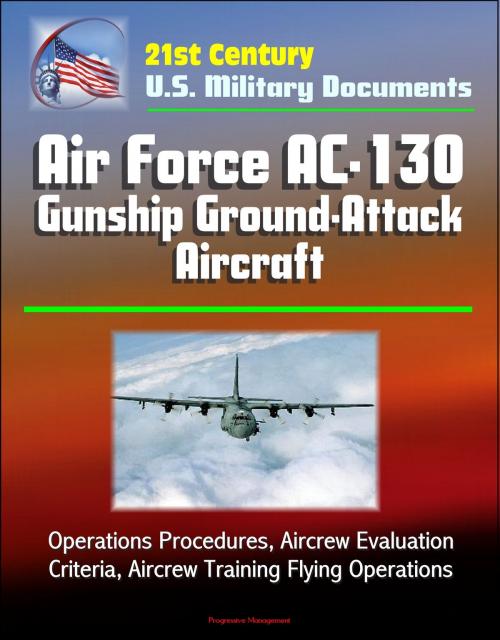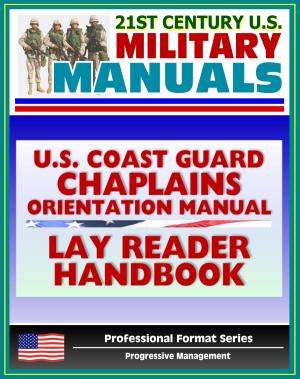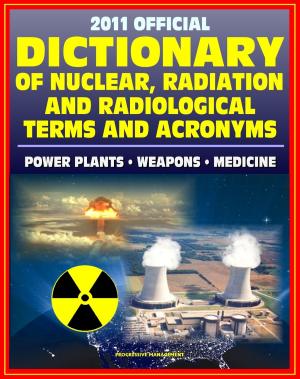21st Century U.S. Military Documents: Air Force AC-130 Gunship Ground-Attack Aircraft - Operations Procedures, Aircrew Evaluation Criteria, Aircrew Training Flying Operations
Nonfiction, Science & Nature, Technology, Aeronautics & Astronautics, History, Military, Aviation| Author: | Progressive Management | ISBN: | 9781301879830 |
| Publisher: | Progressive Management | Publication: | October 16, 2013 |
| Imprint: | Smashwords Edition | Language: | English |
| Author: | Progressive Management |
| ISBN: | 9781301879830 |
| Publisher: | Progressive Management |
| Publication: | October 16, 2013 |
| Imprint: | Smashwords Edition |
| Language: | English |
Three Air Force documents provide unique information about USAF operations of this aircraft.
Operations Procedures - This AFI provides guidelines and restrictions for AC-130 operations and applies to AC-130 aircrews at all management levels concerned with operation of the AC-130. It is a compilation of information from aircraft flight manuals, Flight Information Publications (FLIP) and other Air Force directives, and is an original source document for many areas. Chapter 1 * GENERAL INFORMATION * 1.1. General * 1.2. Applicability * 1.3. Key Definitions * 1.4. Deviations and Waivers * 1.5. Distribution * 1.6. Supplements * 1.7. Requisitioning Procedures * 1.8. Improvement Recommendations * 1.9. Definitions * 1.10. Aircrew Operational Reports * Chapter 2 * COMMAND AND CONTROL * 2.1. Operational Control (OPCON) * 2.2. 23rd Air Force (23 AF) * 2.3. Waiver and Approval Authorities * 2.4. Mission Commander * 2.5. Pilot in Command Responsibility and Authority * 2.6. Airborne Mission Commander (AMC) * 2.7. Deputy Mission Commander (DMC) * 2.8. Mission Clearance Decision * 2.9. Support to Civilian Law Enforcement Agencies * 2.10. AFSOC C2 agencies * Chapter 3 * CREW COMPLEMENT AND MANAGEMENT * 3.1. Aircrew Qualification * 3.2. Crew Complement * 3.3. Additional Crewmembers (ACM) * 3.4. Interfly * 3.5. Alert Crew Procedures * 3.6. Flight Duty Period and Crew Rest Restrictions * 3.7. Scheduling Restrictions * 3.8. Alert Procedures * 3.9. AFSOC Alert Aircraft * Chapter 4 * AIRCRAFT OPERATING GUIDELINES * 4.1. Objectives * 4.2. Policy * 4.3. Aircraft Operating Guidelines * Chapter 5 * AIRLAND OPERATIONS * 5.1. Aircraft Maximum Gross Weight Policy * 5.2. Checklists * 5.3. Duty Station * 5.4. Flight Deck Entry * 5.5. Takeoff and Landing Policy * 5.6. Copilot Landing Policy * 5.7. Landing Gear and Flap Operation In-flight * 5.8. Use of Outside Observers * 5.9. Seat Belts * 5.10. Aircraft Lighting * 5.11. Advisory/Required Calls * 5.12. Communications Policy * 5.13. Pilot Proficiency with Munitions * 5.14. Wind Limitations * 5.15. Runway Condition Reading (RCR) and Runway Surface Condition (RSC) * 5.16. Wake Turbulence Avoidance * 5.17. Runway and Taxiway Requirements * 5.18. Aircraft Taxi and Taxi Obstruction Clearance Criteria * 5.19. Reverse Taxi * 5.20. Buddy and Windmill Taxi Starts * 5.21. Takeoff and Landing Obstruction Criteria * 5.22. Intersection Takeoffs * 5.23. Reduced Power Operations * 5.24. Three-Engine Takeoffs * 5.25. Aircraft Recovery from Unprepared Surfaces * 5.26. Engines Running Onload or Offload (ERO) AC-130H/U * 5.27. Arrival * more
AC-130 Aircrew Evaluation Criteria - The Aircrew Standardization and Evaluation Program is the commander's tool to validate mission readiness and the effectiveness of unit flying, to include documentation of individual aircrew member qualifications and capabilities.
AC-130 Aircrew Training Flying Operations - Training policy, guidance, and requirements are set forth for each phase of aircrew training. The objective of training should be the progressive development of aircrew combat readiness.
Three Air Force documents provide unique information about USAF operations of this aircraft.
Operations Procedures - This AFI provides guidelines and restrictions for AC-130 operations and applies to AC-130 aircrews at all management levels concerned with operation of the AC-130. It is a compilation of information from aircraft flight manuals, Flight Information Publications (FLIP) and other Air Force directives, and is an original source document for many areas. Chapter 1 * GENERAL INFORMATION * 1.1. General * 1.2. Applicability * 1.3. Key Definitions * 1.4. Deviations and Waivers * 1.5. Distribution * 1.6. Supplements * 1.7. Requisitioning Procedures * 1.8. Improvement Recommendations * 1.9. Definitions * 1.10. Aircrew Operational Reports * Chapter 2 * COMMAND AND CONTROL * 2.1. Operational Control (OPCON) * 2.2. 23rd Air Force (23 AF) * 2.3. Waiver and Approval Authorities * 2.4. Mission Commander * 2.5. Pilot in Command Responsibility and Authority * 2.6. Airborne Mission Commander (AMC) * 2.7. Deputy Mission Commander (DMC) * 2.8. Mission Clearance Decision * 2.9. Support to Civilian Law Enforcement Agencies * 2.10. AFSOC C2 agencies * Chapter 3 * CREW COMPLEMENT AND MANAGEMENT * 3.1. Aircrew Qualification * 3.2. Crew Complement * 3.3. Additional Crewmembers (ACM) * 3.4. Interfly * 3.5. Alert Crew Procedures * 3.6. Flight Duty Period and Crew Rest Restrictions * 3.7. Scheduling Restrictions * 3.8. Alert Procedures * 3.9. AFSOC Alert Aircraft * Chapter 4 * AIRCRAFT OPERATING GUIDELINES * 4.1. Objectives * 4.2. Policy * 4.3. Aircraft Operating Guidelines * Chapter 5 * AIRLAND OPERATIONS * 5.1. Aircraft Maximum Gross Weight Policy * 5.2. Checklists * 5.3. Duty Station * 5.4. Flight Deck Entry * 5.5. Takeoff and Landing Policy * 5.6. Copilot Landing Policy * 5.7. Landing Gear and Flap Operation In-flight * 5.8. Use of Outside Observers * 5.9. Seat Belts * 5.10. Aircraft Lighting * 5.11. Advisory/Required Calls * 5.12. Communications Policy * 5.13. Pilot Proficiency with Munitions * 5.14. Wind Limitations * 5.15. Runway Condition Reading (RCR) and Runway Surface Condition (RSC) * 5.16. Wake Turbulence Avoidance * 5.17. Runway and Taxiway Requirements * 5.18. Aircraft Taxi and Taxi Obstruction Clearance Criteria * 5.19. Reverse Taxi * 5.20. Buddy and Windmill Taxi Starts * 5.21. Takeoff and Landing Obstruction Criteria * 5.22. Intersection Takeoffs * 5.23. Reduced Power Operations * 5.24. Three-Engine Takeoffs * 5.25. Aircraft Recovery from Unprepared Surfaces * 5.26. Engines Running Onload or Offload (ERO) AC-130H/U * 5.27. Arrival * more
AC-130 Aircrew Evaluation Criteria - The Aircrew Standardization and Evaluation Program is the commander's tool to validate mission readiness and the effectiveness of unit flying, to include documentation of individual aircrew member qualifications and capabilities.
AC-130 Aircrew Training Flying Operations - Training policy, guidance, and requirements are set forth for each phase of aircrew training. The objective of training should be the progressive development of aircrew combat readiness.















